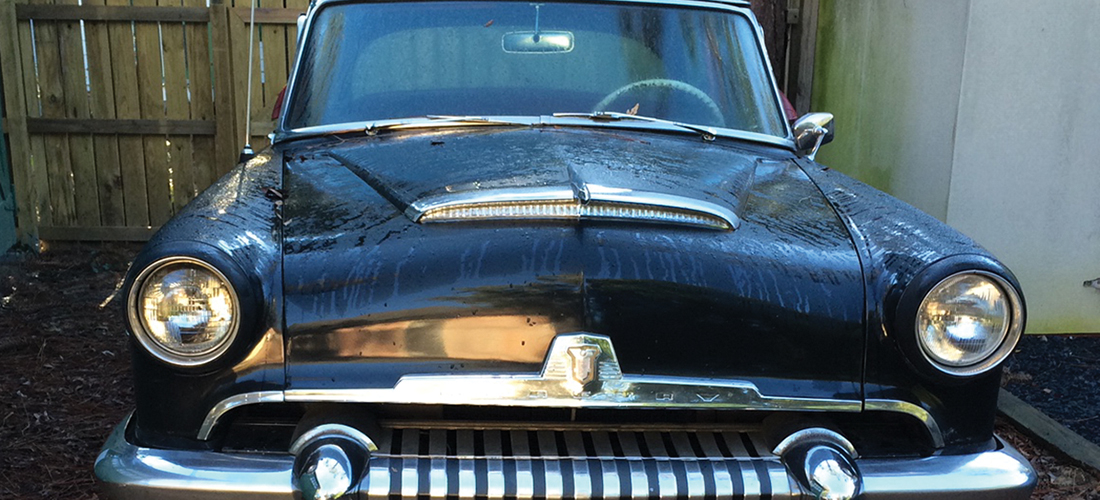
Crazy ’bout a Mercury
The perils and pleasures of owning a classic car
By Bill Case
Lord I’m crazy ‘bout a Mercury
I’m gonna buy me a Mercury
And cruise it up and down the road
— From the song “Mercury Blues,” by Alan Jackson
In 2004, my older brother Tom, an inveterate devotee and collector of antique automobiles who lives in Little Rock, Arkansas, cajoled me into spending Labor Day weekend with him in Auburn, Indiana, attending that city’s Auburn Fall Collector Car Auction. It’s a massive show with over 1,000 classic cars changing hands across a lightning-paced auction block. My brother was an experienced hand at such affairs, having bought and sold — often at a profit — over a hundred classic cars. My personal interest in aged autos was of decidedly lower wattage, though I harbored a sentimental attachment to the “Detroit iron” cars of the 1950s that proudly roamed the nation’s highways during my youth.
My favorite brand from the era was Mercury. This affinity budded decades ago after I saw star-crossed James Dean behind the wheel of his slick, black-as-night ’49 Merc coupe in the epic flick Rebel Without a Cause. I also liked the Mercury’s distinctive appearance. Eyeing a ’50s Mercury Monterey head-on, the chrome-laden grille scowls back at you with bared teeth — akin to the face an NFL linebacker might make just before obliterating a quarterback.
While attending Saturday night’s furious auctioneering melee, I made the fateful mistake of informing Tom that I was partial to old Mercs. He got all excited. “There’s a ’50 Merc coming up for auction in about an hour!” my brother exclaimed. “You ought to bid on it.”
Yeah, right! I was keenly aware I had no business purchasing an antique car. Those who know me will attest that I don’t know the difference between a transmission and a carburetor and would be next to helpless in dealing with an ancient auto’s inevitable breakdowns. In younger days, I occasionally tried changing a tire or an oil filter, but my ineffectual efforts invariably led to injury to the car or myself. Furthermore, I was uncomfortable with the concept of spending serious money on a vehicle that I would not be driving regularly. There was no way I was going to enter the bidding.
Just then, a cream-colored 1940 Ford DeLuxe convertible came on the block, and Tom was immediately smitten. He decided to enter the fray. As his bids kept getting topped, he would mutter to himself, “Linda (his wife) is gonna kill me,” before gritting his teeth and upping the ante. Ultimately, Tom added the Ford to his burgeoning collection.
A talented auctioneer can create an atmosphere that causes folks to shout out bids they never intended to make. Maybe that was what caused me to grab Tom’s bidding paddle and hold it high a few minutes later after the aforementioned mint-green ’50 Merc entered center stage. Or maybe I wanted to show my big brother that I could play this auction game, too. When there was no response to my bid of $10,500, it was apparent this ancient auto would soon be heading to my then home of Columbus, Ohio. But as my exhilaration subsided, reason quickly took its place along with a cloud of buyer’s remorse.
But, wait. A steward’s challenge! I was off the hook several minutes later when the auctioneer announced that my bid had failed to meet the minimum reserve — no sale. Tom was downcast as he had looked forward to my joining him in classic car collecting. I did not have the heart to convey my relief at dodging a bullet.
The reprieve, however, proved to be short-lived. Several months later, Big Tom (he’s 6 feet, 6 inches, rendering me the shrimp sibling at 6 feet, 1 inch) alerted me he had located a 1954 black Mercury Monterey sedan in Arkansas that I absolutely must buy. “This is a far more drivable Merc than the one at Auburn because it has power steering,” he urged. “It’s in good condition but not so perfect that you’ll be afraid to take it out on the road.” With his typical acumen in such matters, he had negotiated a bargain-basement price of $8,000.
I tried to put up roadblocks, but Tom easily knocked them down. I confessed my second thoughts about coughing up money for an antique car, but he rebutted that by pointing out the price was substantially less than I had been willing to spend at the Auburn auction. When I raised a concern about the expense of shipping the car to Columbus from Arkansas, Tom brushed it aside. The seller had agreed to handle the 725-mile transport at his own expense. Tom sought to remove my last bit of resistance with this tantalizing tidbit: “This Mercury,” he revealed, “was on the set of the Johnny Cash movie Walk the Line, and you’ll get a picture of the car when it was on the set!” It seems silly that this information would play any role whatsoever in my decision-making, but my brother knew his mark. I caved.
Once the deal was made, I cast aside my doubts, adopting an attitude of eager anticipation as I awaited the appearance of my new toy. When the Merc arrived (along with the Walk the Line movie set photo), I was delighted. Tom was right; this was the car for me. Though five years newer, this Merc looked a lot like the black James Dean auto that had originally attracted me to the brand. It also sported snazzy red and black upholstered bench seats — the type that enabled guys in the ’50s to woo their dates by putting an arm around a girl and holding her close. The over-sized steering wheel and unusual joystick levers that controlled the heater and vents also appealed to me.
At first, the car ran beautifully, and I took pleasure in returning the appreciative waves of pedestrians and horn beeps of fellow motorists, most of whom smiled broadly when observing this relic of the distant past. Initially a skeptic of the purchase, significant other (now wife) Lisa was now taking to the Merc, enjoying our summer evenings motoring to the Dairy Queen.
Realizing that motorheads would likely be quizzing me about the car, I studied up on the model’s history. I learned that the ’54 Monterey was equipped with a V-8 engine carrying 161 horsepower. An automatic transmission called the “Merc-o-matic” had also been installed by the manufacturer. I thought this info would be enough to bluff my way through encounters with car guys. Not so much. A typical conversation went like this:
Car guy: What’s the engine?
Me: V-8.
Car guy: Is ’54 the year Mercury went to the overhead valve Y block V-8 engine or was it still the flat head V-8?
Me: Ah, it has 161 horsepower. It’s really got some nice acceleration.
Car guy: Oh, then that’s the one with the twin Tornado combustion chambers. Right?
Me: Did I tell you it’s got a Merc-o-matic transmission?
After a couple of like encounters, I abandoned any pretense of expertise, and freely admitted my cluelessness regarding the Merc’s mechanics — I just liked how the Merc looked driving it around. Typically, the auto mavens found this disclosure deeply disappointing as though my lack of ardor for diving under the hood was an admission of a distasteful character flaw. Our conversations ended quickly.
This null set of car knowledge was bound to catch up with me, however, and it did after the Merc began stalling at inopportune times, nearly always when Lisa occupied the passenger seat. Periodically the Merc would resist my restarting efforts and we’d wind up stranded in downtown Columbus. In one unfortunate incident that I have tried to forget, the Monterey sputtered to a halt next to a biker bar in a dodgy part of town a few miles from our home. It took 30 tense minutes, but I finally got the recalcitrant sedan running again. My hope was to nurse the Merc back to the house, where I could exchange it for my regular car and, assuming Lisa would not want to risk being stranded on the interstate, I suggested she remain at the bar. The idea was not greeted with universal gratitude for my thoughtfulness. The words my wife utters to this day ring in my ears, “I can’t believe that you want to ditch me at a biker bar!”
Given that the Mercury’s misbehaviors invariably seemed to occur with Lisa as an eyewitness, she concluded that the car must be waging a personal vendetta against her. She likened the Merc to another ’50s era automobile called “Christine” from the eponymously named 1983 Stephen King horror movie. The evil cherry-red ’58 Plymouth Fury left a path of mayhem and destruction in its wake. The biker bar debacle finally caused Lisa to issue an ultimatum, “Either get the car fixed or I’m not getting in it anymore.”
Unlike the spooky Christine, the Merc was incapable of repairing itself so I cast about for a classic car mechanic who could solve the chronic stalling problem. Someone I knew recommended his neighbor, Shane, who moonlighted performing mechanical miracles on antique cars. Upon meeting him, I confess I was not all that impressed, but Shane assured me he could make the fix. Not presently aware of other alternatives, I consented to have him undertake the job. A week later, Shane pronounced the Merc good as new. And for a week, it was. I persuaded Lisa it was safe to get back inside.
Then, on a crisp fall night enjoying an outing on Riverside Drive, as we commenced a long, uphill climb, our respective hearts skipped beats when the engine suddenly stalled and the Merc stopped cold on the highway. It was pitch dark and the black car had no flashers. No berm existed alongside the road, just a guardrail about a foot off the edge of the right lane. I feverishly restarted the car. It crept a few yards up the hill and stalled out again. In full panic mode, I begged Lisa to get out and push. This was only marginally better than my biker bar idea. I doubt whether a gym full of heavyweight powerlifters would have possessed the strength to inch the big Merc up the steep incline.
Vehicles whizzing by were being forced to make last-second maneuvers into the oncoming lane to avoid the Merc. Somehow I had to find a way to get it up to the summit of the hill a quarter mile away. Lisa was justifiably scared and so was I.
I will be forever grateful to the cab driver who recognized our predicament and, at some risk to himself, stayed behind as our rear guard, flashing his taxi’s emergency lights while I desperately managed the Merc’s agonizing start-stall-start-stall journey to the hillcrest. We breathed a joint sigh of relief and coasted down to safety.
Lisa was correct. If the car could not be safely operated, it had to go. At a neighborhood party, my sympathetic friend, Sid, recommended I take the car to the local Mercury dealer. “They may have a veteran mechanic still on the payroll who worked on ’50s cars back in the day,” he said. “Or the dealer might refer you to one of their retired mechanics who still works on Mercurys.” Why hadn’t I thought of that? The dealership sent me to Rennie, a 40-year employee who had repaired dozens of vintage Mercs like mine.
Voila! After Rennie worked his magic, the Mercury purred like a kitten. Lisa was satisfied with the car’s improved reliability, and we resumed our runs to the Dairy Queen without fear of sudden calamities. I drove it often in Columbus, recording in excess of 25,000 miles on the odometer over 10 years. Tom says that’s more mileage than he has driven all of his 100 classic cars combined.
The Monterey was running pretty much on all cylinders before Lisa and I moved to Pinehurst in October 2014. Though no longer comparing the Merc to Christine, she nonetheless thought that after a decade of ownership, it was time to get rid of the old boy. Though it remains arguable that I still have no business owning an antique car, I couldn’t bear to give it up. We had too much history together. It found a new home in Pinehurst, too. I was lucky to discover an able mechanic, Dean, at Resto-Euro in Aberdeen, who has the car running smoothly. I obtained “54 MERC” for the car’s license plate from the DMV. If any other 1954 Mercurys are still on the road in North Carolina, I suspect that plate would have been previously snapped up.
I don’t drive it at night anymore, and I wouldn’t dream of motoring it further than Southern Pines, but after 65 years on the road, it endures — a sweet ride. Just wave or beep your horn if you should happen to see me behind the wheel of my scowling ‘54 Merc. Chances are you’ll get the opportunity. PS
Pinehurst resident Bill Case is PineStraw’s history man. He can be reached at Bill.Case@thompsonhine.com.





